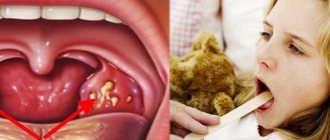November 15, 2021
56 411
18 minutes
Author, editor and medical expert – Klimovich Elina Valerievna.
The term “tonsillitis” or “acute tonsillitis” refers to an infectious inflammatory disease that occurs with damage to one or more tonsils of the pharyngeal lymphoid ring.
The pharyngeal lymphoid ring surrounds the entrance to the respiratory tract and digestive tract and performs a protective function. It participates in the formation of immunity, neutralizes viruses, bacteria and other microorganisms that enter the body from the external environment through the mouth and nasal openings.
The pharyngeal ring includes six large accumulations of lymphoid tissue - tonsils:
- 2 palatine (tongs), located on both sides of the entrance to the pharynx;
- 1 lingual, located at the root of the tongue,
- 1 pharyngeal - in the upper part of the nasopharynx on its back wall,
- 2 tubes - directly at the entrances of the auditory tubes.
Sore throat is usually called inflammation of the tonsils, although the term is also applicable to other localizations of the inflammatory process1.
Up to contents
Causes of sore throat in children
The disease is more common in school-age children and teenagers2. Sore throat in a child under 2 years of age is rare and is caused by insufficient development of the lymphoid tissue of the pharynx2.
In the vast majority of cases, tonsillitis develops as an infectious process2.
- Primary (banal) it can be caused by:
- beta-hemalytic streptococcus A;
- streptococci C G;
- staphylococci, pneumococci and other bacteria;
- viruses: respiratory parainfluenza viruses, adenoviruses, coronaviruses, respiratory syncytial viruses, roto- and enteroviruses, Coxsackie viruses, herpeviruses, etc.2
- Secondary inflammation can develop:
- for childhood infections (measles, rubella, scarlet fever);
- for syphilis, tuberculosis;
- as one of the symptoms of leukemia or agranulocytosis2.
The high susceptibility of children to viruses and streptococcus causes the widespread prevalence of tonsillitis. The source of infection is always a person – a patient or a carrier of the pathogen.
In the case of viral processes, these are patients with ARVI, measles, rubella, etc., in the case of catarrhal or purulent tonsillitis caused by streptococci, these are patients with tonsillitis.
The route of transmission of pathogens is airborne droplets or contact. Microbes are transferred from the patient into the environment along with sputum when sneezing and coughing. They are introduced into the body of a healthy baby with dirty hands, when using shared dishes, household items and hygiene items, during close contact, for example, when kissing.
The development of tonsillitis is promoted1,2:
- hypothermia, which often happens in the autumn-winter period and early spring;
- overwork, in particular excessive loads associated with training, attending numerous clubs and studios;
- unbalanced diet - predominance of carbohydrate foods in the diet, lack of vegetables and fruits rich in vitamins and essential microelements,
- the presence in the body of a focus of chronic infection (runny nose, sinusitis, caries, otitis media and others);
- decreased immunity after acute respiratory viral infections and other diseases suffered the day before;
- primary immunodeficiency.
Up to contents
How and why does infection occur?
Infection occurs by airborne droplets, from a sick person, by using shared utensils and eating contaminated food, as well as by a number of other factors:
- weakened immunity;
- hypothermia or consumption of cold foods and drinks;
- mouth breathing (for chronic adenoiditis, deviated nasal septum);
- irritation of the nasopharyngeal mucosa with a runny nose;
- recent viral diseases;
- inflammatory diseases of the ENT organs (sinusitis, sinusitis, otitis);
- caries and other oral infections.
Secondary tonsillitis in children can occur against the background of scarlet fever, diphtheria, mononucleosis, as well as blood diseases.
In any case, a sore throat develops rapidly, in a matter of hours, and is especially acute in children, accompanied by the main symptoms—a sore throat when swallowing and an increase in body temperature.
Forms of the disease in children
All types of acute tonsillitis occur in children, but their prevalence depends on age.
Sore throat in a child 1-3 years of age is more likely (44% of cases) associated with a herpetic infection2. Only 35% of cases of the disease are the result of the activity of streptococci2.
In children aged 3 to 7 years, tonsillitis is more often bacterial, but streptococci are found only in 28% of cases2. Further, the picture changes towards the predominance of streptococcal infection and in adolescents it already accounts for up to 52% of cases of inflammation.
According to the picture of pathological changes in the tonsils1, inflammation of the tonsils can be:
- Erythematous (catarrhal), accompanied by redness of the tonsils and palatine arches. Viral tonsillitis, streptococcal (in the initial stages of development) or atypical, caused by Yersinia, mycoplasma, chlamydia, have such a clinical picture.
- Vesicular, characterized by the appearance of vesicles with turbid liquid on the tonsils, after opening of which small erosions form on the mucous membrane. This is how herpetic sore throats, tonsillitis with measles, and chickenpox occur.
- Membranous, in which purulent or necrotic films appear on the tonsils1. In lacunar forms, the film forms pus flowing from the lacunae, which is easily removed with a swab2. True films in diphtheria are firmly connected to the underlying tissue of the tonsils2.
According to the severity of the course, acute tonsillitis in children can be:
- light,
- moderate severity,
- heavy.
With the flow:
- without complications,
- with complications.
Up to contents
What is a sore throat?
Sore throat, or tonsillitis, is a disease in which an inflammatory process occurs in the palatine tonsils, or, in other words, tonsils. Tonsils are a collection of lymphoid tissue. They perform the most important function in the body - protective. If bacteria or viruses enter the body during breathing or through food intake, the tonsils “meet” them first, neutralize them and remove them from the body. As long as the number of pathogenic microorganisms does not exceed the permissible norm, the tonsils easily cope with their task, but as soon as the microorganisms become active, the tonsils begin to work doubly intensely, as a result of which an inflammatory process occurs in them. The body begins to produce an increased number of white blood cells to cope with enemies. And such a “fight” lasts three to four days until the pathogens are eliminated. But the situation is complicated by the fact that inflammation is accompanied by swelling, enlarged tonsils and other unpleasant symptoms, which will be discussed later.
Symptoms of the disease
Despite the variety of forms, the signs of tonsillitis in children are largely similar. Let us analyze the clinical picture of the disease using the example of the most dangerous streptococcal inflammation1,2.
The incubation period ranges from several hours to 4-5 days - on average 2-4 days3. The onset of the disease is acute - symptoms of infection appear and develop quickly. The introduction of microbes into the tissue of the tonsils leads to their inflammation and the formation of a large amount of toxins. Their absorption causes poisoning of the body and the appearance of general symptoms of intoxication.
General symptoms:
- From the nervous system, weakness, drowsiness, lethargy, tearfulness and headaches are noted. A child of 2-3 years old during a sore throat usually becomes lethargic, begins to be capricious, cry for no reason, goes to bed in the daytime, although he usually refuses to sleep during the day. Older children complain of fatigue.
- Fever occurs as a result of irritation of the thermoregulation center by streptococcal toxins2,4. Sore throat in children is usually characterized by a rapid rise in temperature to 390 C and above, accompanied by chills, pale skin and lips, and cold extremities4.
- Febrile seizures in children (usually under 3 years of age) can occur against the background of a rapid rise in temperature4. They are expressed in twitching of individual muscle fibers or muscles, or in the form of a general seizure, in which the baby’s entire body tenses and bends in an arc.
- Nausea and vomiting, abdominal pain indicate a severe course of the disease1.
- Body aches, muscle and joint pain : Young children may complain of pain in their arms and legs1.
Local symptoms
These are the visible changes occurring in the throat and the sensations they cause. Depending on their nature, catarrhal, follicular, lacunar tonsillitis, as well as necrotic (ulcerative-necrotic, membranous-necrotic) acute tonsillitis are distinguished.
Catarrhal inflammation develops in all cases as the initial stage of the pathological process 1.3. If the immune system is strong and antibacterial treatment of a child’s sore throat is started on time, the disease can stop at this stage and then begin its reverse development3.
The tonsils, arches, soft palate and uvula look red and swollen. There are no raids on them. The baby develops a foreign body sensation, sore throat and sore throat when swallowing, and drooling.
Follicular tonsillitis is characterized by purulent melting of the follicles of the tonsils. Through the inflamed bright red mucous membrane of the tonsils, whitish-yellowish islands, the size of a grain of rice (3-4 mm), are visible. In this case, there is no pus on the surface of the tonsils - it is located inside under the mucous membrane.
In the case of lacunar tonsillitis, yellowish-white pus is secreted from the lacunae onto the surface of the tonsils and covers them with a thin layer, forming easily removable films. The smell from the mouth becomes sweetish-sweet, putrid, the pain in the throat becomes constant, independent of food intake. The baby's appetite decreases and he refuses to eat.
With necrotic sore throat in children, the throat looks uniformly red, large, 1-2 cm in size, areas appear on the tonsils, covered with a “pearly” dirty gray coating. The plaque is tightly bound to the underlying tissues. After its rejection, deep bleeding ulcers form on the surface of the tonsils. The development of necrotic processes indicates a severe course of the disease.
In all cases, streptococcal inflammation spreads to nearby (regional) lymph nodes. They are felt on the neck, below the corners of the lower jaw in the form of painful round formations, the size of which depends on the severity of the disease.
Severity
The disease can occur in mild, moderate and severe forms.
| 1. Light | A sore throat in a child over 5 years old can occur without pronounced symptoms of intoxication with mild weakness, low-grade fever (below 380 C) for 1-5 days, mainly with catarrhal changes in the tonsils, some pain and enlarged lymph nodes up to 1 cm3. This type of flow is considered mild . In children in the first years of life, the disease is often more severe. |
| 2. Medium-heavy | The moderate severity of the disease is indicated by the moderate severity of the general symptoms of angina: temperature above 38.50 C, weakness, headaches and body aches last for 6-8 days3. The tonsils are covered with purulent films and clear no earlier than after 4-6 days3. The lymph nodes are enlarged to 2 cm, but, despite the severity of the condition, there are no complications3. |
| 3. Heavy | A severe course is characterized by the appearance of severe symptoms of intoxication, including vomiting, abdominal pain, and diarrhea. A temperature above 39.50 lasts up to 9 days, exhausts the little man, and is often accompanied by febrile convulsions. In the pharynx there is a picture of filmy or ulcerative necrotic tonsillitis. Lymph nodes reach 3 cm in size. The tonsils are cleared after a week or even later. |
Up to contents
What are the complications?
Complications after an illness can be quite serious. The most common complication is rheumatism. This means that the pathogen has penetrated the heart and joints. To avoid cardiac rheumatism - myocarditis, and sometimes bacterial endocarditis, it is necessary to minimize the child’s physical activity during the illness.
Another common complication is kidney dysfunction and inflammation - glomerulonephritis.
By moving towards the brain, the pathogen can provoke inflammation of its membrane - meningitis. This disease is extremely difficult to treat, and its consequences for the child’s body are irreparable. If the disease is not treated, there is a high probability of death.
The occurrence of parathonsillar and parapharyngeal abscess, chronic tonsillitis, adenoids, hypertrophy (enlargement) of the palatine tonsils, otitis media, conductive hearing loss is only an incomplete list of the consequences of improper or delayed treatment of tonsillitis.
Diagnostics
Inflammation of the palatine tonsils is sometimes accompanied by severe swelling, which can spread to the underlying parts of the respiratory tract and lead to severe difficulty breathing. Against the background of intoxication, cardiovascular failure and shock may develop3. Therefore, it is impossible to treat sore throat in children at home without consulting a doctor.
The clinical picture of angina is obvious. Whether or not there is inflammation can be seen when examining the throat. The main question that the doctor has to answer before starting treatment is what infection caused the inflammation.
- Viral tonsillitis caused by respiratory viruses is usually catarrhal1 and is accompanied by other symptoms of ARVI: discharge from the nasal passages, sneezing, nasal congestion, cough, conjunctivitis and others2. In the herpetic form, small blistering rashes are visible on the mucous membrane of the palate, uvula and tonsils.
A viral infection does not require antibacterial therapy; it can be treated with symptomatic means1,2.
- Diphtheria is the main danger2. Its main feature is the discrepancy between the severity of intoxication and sore throat and the changes occurring in the tonsils2. By the end of the first day of the disease, against the background of malaise, low-grade fever and mild sore throat, the tonsils become covered with a white-gray “pearly” film. In this case, the surrounding mucosa looks more bluish than red, and the lymph nodes practically do not enlarge.
As the pathological process develops, the temperature increases to 400 C, the baby begins to become delirious, and plaque covers not only the tonsils, but also the palate and uvula2. Swelling can spread to the airways and neck, making breathing very difficult.
Treating such a sore throat in a child at home is strictly prohibited!
- Candidal tonsillitis is one of the manifestations of a common fungal infection that accompanies HIV and other severe immunodeficiency conditions2. Since they are rare in childhood, candidal tonsillitis in a child 4-7 years old is more of a casuistry than a reality.
With candidiasis, the plaque is curdled; it covers not only the tonsils, but also other areas of the mucous membrane of the oral cavity and pharynx. There is no fever, the lymph nodes are not enlarged. Treatment primarily includes antifungal drugs2.
To accurately determine the causes of the disease, laboratory diagnostics are performed. It includes:
- microbiological analysis of a smear from the surface of the tonsils and the back wall of the pharynx to identify the causative agent of infection and determine its sensitivity to antibiotics1 (result after 1-2 days);
- rapid tests for streptococcus, allowing diagnosis within 10-15 minutes1,2;
- swab from the throat on a Lefler stick (to exclude diphtheria).
Based on the results obtained, treatment for acute tonsillitis is prescribed.
Up to contents
Types of sore throats
The mildest form of the disease is catarrhal. It is characterized by a slight increase in temperature, pain and dryness in the throat. With proper treatment, the illness lasts from three to five days. The disease can be easily confused with ARVI. Therefore, it is important to see a doctor to confirm the diagnosis - because treatment regimens for these two diseases differ.
Follicular tonsillitis is characterized by a more severe course. The body temperature rises to 38°C, the lymph nodes are greatly enlarged, and painful sensations appear when pressing on them. There are noticeable pustules on the tonsils, similar to white-yellow bumps, which burst within three to five days, after which significant relief occurs. The illness lasts about a week.
Another type of sore throat, very common in children, is lacunar. On the surface of the tonsils there are winding canals - lacunae. It is in them that bacteria and viruses often hide. With this type of disease, purulent masses fill the gaps, and a white coating becomes noticeable on the surface of the tonsils. The disease is quite difficult.
The signs of fibrous tonsillitis are very similar to those of follicular and lacunar tonsillitis. But a white film appears on the tonsils, which is why the disease can be confused with diphtheria. To make a correct diagnosis, it is necessary to take a smear from the surface of the tonsils.
Sometimes the disease is caused by a herpes virus. This type of sore throat is called herpes. It occurs with high fever up to 40°C, nausea, vomiting, and diarrhea. There are noticeable reddish blisters on the tonsils.
Fungal tonsillitis in childhood is rare. A characteristic symptom for it is the appearance of a cheesy coating on the tonsils.
The mixed form of the disease is especially difficult when the causative agents are several types of microorganisms. Mixed type tonsillitis can cause serious complications.
Treatment of sore throat in children
Mild forms of the disease can be managed at home, under the supervision of a local doctor3. An exception is sore throats in children under one year of age: they need to be treated only in a hospital3.
Moderate and severe tonsillitis at any age is an indication for hospitalization, as are any forms of inflammation in children with immunodeficiencies, developmental defects and diseases of the nervous system3.
Mode
In the first 3-4 days of illness, bed rest is indicated2.
Diet
The diet is gentle, with a predominance of dairy and vegetable dishes, limiting salt, sugar, and excluding spices and herbs.
Drink plenty of fluids
It prevents dehydration due to fluid loss during fever and helps reduce symptoms of intoxication.
Antibacterial and antiviral therapy
Bacterial inflammation requires treatment with antibacterial drugs in the form of tablets, injections or intravenous infusions - it is prescribed by a doctor. Regardless of how long the temperature lasts, if a child has a sore throat, the duration of treatment with antibiotics is at least 10 days2,3.
It makes no sense to give your baby antiviral drugs, since respiratory viruses, which most often cause tonsillitis, are practically insensitive to them1. In addition, viral forms of the disease are mild1,2.
Antipyretic drugs
WHO recommends the use of antipyretic drugs in previously healthy children only if the temperature rises above 390 C, and if heat is poorly tolerated: headache, aching muscles and joints2. For babies under one year of age, as well as children prone to seizures, fever medicine should be given earlier - as soon as the temperature reaches 380 C.
In other cases, you need to use physical methods to combat the fever: light clothing, a fan, rubbing, cold compresses on the forehead, armpits and groin area2.
Local treatment
It includes gargling with special solutions, irrigating the tonsils, and sucking special tablets containing antiseptic, anti-inflammatory and analgesic components.
To gargle with a sore throat, children from the age of three can use HEXORAL® SOLUTION for gargling based on hexethidine5. Hexetidine is active against bacteria, including beta-hemolytic streptococcus, respiratory viruses and fungi, and has a mild analgesic effect, so it can be used as an adjunct to the main treatment of tonsillitis5.
HEXORAL® SOLUTION is not suitable for children who, due to age and lack of skill, simply do not know how to gargle. For such cases, there is HEXORAL® in the form of an AEROSOL, which is evenly sprayed over the entire surface of the pharyngeal mucosa and provides the necessary therapeutic effect6.
For a 4-year-old child, HEXORAL® TABS7 is suitable, and for sore throat in a child 6 years of age and older, HEXORAL® TABS CLASSIC8. HEXORAL® TABS7 contains, in addition to the antiseptic component, the local anesthetic benzocaine, which helps fight sore throat and facilitate swallowing7,8. The composition of HEXORAL® TABS CLASSIC8 includes two antiseptic components, amylmetacresol and dichlorobenzyl alcohol, which enhance the antiseptic effect of each other. The pleasant orange, lemon, honey-lemon, and blackcurrant taste of the tablets is usually liked by children and encourages them to undergo treatment8.
HEXORAL® TABS EXTRA is intended for children over 12 years of age9. It contains lidocaine, a powerful pain reliever that helps fight even the most severe sore throat9.
Please note that after using the drugs, the patient should not be allowed to eat or drink for half an hour.
Up to contents
How does a sore throat appear?
Tonsillitis most often has a bacterial nature: the causative agent of the disease is bacteria such as staphylococcus, streptococcus and adenoviruses. Two thirds of all diseases are caused by β-hemolytic streptococcus. But this bacterium has an unpleasant property: it secretes a special enzyme and becomes invulnerable to cells of the immune system (phagocytes), which normally absorb harmful bacteria, thereby destroying them. What should a child’s body do in this case? Nature has found a way out: the body begins to intensively produce antibodies that successfully cope with foreign microorganisms. But the problem is that these antibodies begin to mistake the body’s own cells for “enemies.” And this is already fraught with the development of serious complications. Therefore, sore throat is considered to be an insidious disease: incorrect or late treatment of the disease in children or its complete absence can lead to serious consequences.
There are a number of reasons that contribute to the development of the disease. These include:
- weak immunity;
- the presence of chronic inflammation in the tonsils;
- the presence of infection in the ENT organs (sinusitis, otitis media);
- adenoids, a deformed nasal septum, polypous formations - all this interferes with normal nasal breathing and contributes to the development of inflammation;
- source of infection in the oral cavity (for example, carious teeth).
It is worth noting that sore throat is a highly contagious disease. To get sick, it is enough to share the same household items with the sick person. In the case of children - only toys. Therefore, it is not surprising that if one child in a kindergarten or school gets sick, the majority will get sick.
Complications of sore throat
The reason for the development of complications is often a late start of treatment, incorrect selection of antibiotics and a sharp weakening of the immune system2.
- Streptococcus has an allergenic effect on the body3, creates the preconditions for the development of nephritis (inflammation of the kidneys), myocarditis (inflammation of the heart muscle), rheumatism, manifested by the development of heart defects and inflammation of the joints, systemic connective tissue diseases, such as systemic lupus erythematosus, Sjogren's syndrome, systemic vasculitis , scleroderma.
- Aggressive streptococcus can penetrate from the tonsils into the surrounding tissues, causing the formation of paratonsillar and retropharyngeal abscesses, periadenitis (inflammation of the lymph nodes), phlegmon - diffuse purulent inflammation of the tissues.
- The list of complications of tonsillitis includes otitis (inflammation of the middle ear), sinusitis (damage to the paranasal sinuses).
- The infection can enter the blood, spread throughout the body and cause the formation of purulent foci in other organs (septicopyemia).
Sore throat and acute tonsillitis in children should be taken seriously.
Consultation with a pediatrician and ENT doctor is necessary in any case, even if at first glance the patient’s condition does not cause much concern!
Self-medication is fraught with the development of complications - all parents should understand this.
Up to contents
The information in this article is for reference only and does not replace professional advice from a doctor. To make a diagnosis and prescribe treatment, consult a qualified specialist.
Possible complications
As a rule, the viral form of tonsillitis, if a sore throat is treated correctly and in a timely manner, does not pose a danger and goes away without complications.
ARVI can be complicated by the addition of a bacterial infection of the nasal cavity: a characteristic sign is green discharge from the nose. The prognosis for this development is favorable, just the duration of treatment will increase by several days.
Influenza viruses cause complications more often than other viruses. This can be pneumonia, lung abscess, hepatitis, diseases of the heart muscle, neuritis. Adenoviruses can cause sinusitis and pneumonia.
A common consequence of viral tonsillitis is infection of the oral cavity and pharynx by fungus. Bacterial tonsillitis often develops. Exacerbations of chronic diseases are possible.
Literature
- T.I. Garashchenko. Sore throats in children and their systemic antibacterial therapy. Consilium Medicum. Pediatrics. (Add.) 2008; 02: 14-20.
- E. I. Krasnova, N. I. Khokhlova. Differential diagnosis and treatment tactics for acute tonsillitis (angina) at the present stage. Attending physician No. 11/2018; Page numbers in the issue: 58-63.
- Clinical recommendations (treatment protocol) for providing medical care to children with tonsillitis (acute streptococcal tonsillitis), FSBI NIIDI FMBA of Russia, 2015.
- Tatochenko V.K.. Once again about antipyretics. Issues of modern pediatrics. Volume 6 No. 2 2007, p. 128-130.
- Instructions for the drug HEXORAL® SOLUTION.
- Instructions for the drug HEXORAL® in AEROSOL form.
- Instructions for the drug HEXORAL® TABS.
- Instructions for the drug HEXORAL® TABS CLASSIC.
- Instructions for the drug HEXORAL® TABS EXTRA.
Up to contents
Treating sore throat correctly
Sore throat is a dangerous disease, so you need to immediately discard the idea that everything will go away on its own or that you can only be cured with folk remedies. Treatment of angina in children should be carried out only under the supervision of an otolaryngologist. In order to choose the right treatment regimen, it is necessary to understand what pathogen we are dealing with. If a sore throat is caused by bacteria, treating it with antiviral drugs is pointless if the cause of the disease is a virus, for example, herpes, which cannot be treated with antibiotics. Therefore, only an ENT doctor should prescribe complex therapy! When treating the disease, the following drugs are usually used:
- Antibacterial drugs are the main weapon in the fight against pathogenic microorganisms. The choice of drug, dosage and course of treatment remains with the attending physician. You cannot interrupt the course of treatment on your own, even if the baby is on the mend.
- Local medications - antiseptics (Furacilin, Miramistin, Ingalipt, Hexoral, Tantum Verde, etc.), which relieve pain in the throat and improve the general condition of the baby.
- Antihistamines - prescribed to relieve swelling of the mucous membrane.
- Antipyretics - at high body temperatures (from 38.5°C in children and from 37.5°C in infants), medications based on ibuprofen or paracetamol should be taken.
- Probiotics - do not forget to restore the functioning of the gastrointestinal tract, disturbed while taking antibiotics.
- Vitamins that strengthen the body's immune system.
- Physiotherapeutic and antiseptic procedures - their choice depends on the age of the patient and is prescribed strictly by an ENT doctor. At the ENT clinic, the baby will undergo: ultrasonic medicinal irrigation of the palatine tonsils and the back wall of the pharynx, irrigation with an antiseptic on an ENT machine, lubrication of the tonsils with an iodine-based antiseptic. Among the physical influences, a session of laser therapy, ultraviolet irradiation and vibroacoustic therapy will be useful.
All this certainly quickly stops all signs of inflammation and promotes a speedy recovery.
When treating a child, it is very important to create favorable conditions for recovery. The patient is prescribed bed rest, a balanced diet (food should not be hot, hard or spicy, so as not to irritate a sore throat), and be sure to drink plenty of fluids. It is necessary to constantly ventilate the room where the patient is lying, and, if possible, not allow him to come into contact with other family members, because the disease is extremely contagious.
Prevention of sore throat
In order to reduce the likelihood of tonsillitis (acute tonsillitis) to a minimum, parents need to take a competent approach to strengthening the child’s immune system. To do this, the following preventive measures should be observed:
- Lead an active lifestyle - take frequent walks in the fresh air, involve your child in sports activities (running, swimming, football, cycling, etc.).
- Provide the child with a balanced diet - introduce a large amount of fresh vegetables and fruits, herbs, low-fat protein foods into the children's diet, and also limit the consumption of fatty, fried foods, fast food, and fast carbohydrates.
- Monitor the child’s personal hygiene, develop in young children the habit of brushing their teeth and washing their face daily (dental caries can cause infection in the tonsils).
- Ensure comfortable conditions in the children's room - maintain optimal humidity and air temperature (no more than 23C at a humidity of 50-60%), carry out daily wet cleaning and ventilation of the rooms.
- If any symptoms of diseases of the ENT organs occur, bring your child for medical examinations in a timely manner, trust only qualified specialists!
We employ experienced doctors of various specialties who will establish an objective diagnosis and select the correct treatment so that the baby can return to his normal lifestyle as soon as possible!
Description of the disease
Sore throat (acute tonsillitis) is a common disease of the upper respiratory tract, characterized by the presence of an inflammatory process in the tonsils (tonsils).
The main reason for the occurrence of pathology is the penetration of pathogenic microorganisms into the child’s body. When microorganisms enter the oral cavity, they first encounter the palatine tonsils, a part of the human lymphatic system responsible for the safety of the body. The tonsils begin to fight pathogenic microflora, producing special antibodies that remove “pests” from the body. The danger is this: sometimes the immune system cannot cope with the infection, the tonsils become inflamed and themselves become a source of infection.
If the disease is not treated in a timely manner, all systems of the child's body are at serious risk - complications such as rheumatic disease, infectious arthritis, nephritis, meningitis and other health-threatening pathologies may arise.
Let's try to understand the important question of how to cure a child's sore throat, preventing the development of complications and relapses.
How can an ENT doctor help with frequent sore throats in a child?
In a specialized ENT office, an otolaryngologist will conduct an endoscopic examination of the ENT organs, which is the gold standard for diagnosing hypertrophy and chronic inflammation of the adenoids, and will also examine the condition of the tonsils for the presence of pathological contents in the lacunae of the tonsils, conduct a streptotest to identify the bacterial carriage of hemolytic streptococcus, the most common causative agent. tonsillitis and showing a high risk of developing autoimmune complications.
What type of sore throat is it?
The disease is divided into several types depending on the cause that caused it and the pattern of the disease. To determine the specific type, the doctor examines the patient’s throat.
- Catarrhal. The easiest possible option. With modern methods it can be cured in about 2 days, but without treatment it can develop into a severe form.
- Follicular. Identified by festering follicles. Yellowish bubbles are observed on the membranes of the throat.
- Lacunarnaya. The main symptom is a yellow coating in the gaps.
- Fibrous. The follicles burst and their contents can be seen on the tonsils.
- Herpetic. It is determined by the appearance of bubbles on the tonsils and pharynx.
- Phlegmous. If one of the above-described forms is not treated, a phlegmous, severe variety will occur.
- Ulcerative-necrotic. It appears as dead areas on the tonsils.
Bacterial sore throat
Bacterial tonsillitis (BT) is a serious condition in which severe intoxication, weakness, headache, sore throat are felt, and catarrhal symptoms (cough, runny nose) are minimally expressed or completely absent. With BT, you can see a whitish coating on the tonsils. Without fail, the specialist observing your child must clarify the diagnosis, that is, exclude infections with similar symptoms. With bacterial sore throat, small white pustules the size of a grain form. In other infections, purulent discharge forms a uniform “film” over the affected areas of the throat. Enlarged lymph nodes in the neck under the jaws are a common symptom of the disease.
Causes of asthma
In addition to streptococci, which are the main pathogens, the disease can be caused by other bacteria, for example, pneumococcus, one of the most common causes of bacterial infectious diseases in children. The disease can also be provoked by staphylococci, bacilli - Pseudomonas aeruginosa and intestinal and opportunistic microflora of chlamydia, ureaplasma, mycoplasma.
Diagnosis of bacterial sore throat
First of all, the specialist must determine whether there have been cases of sore throat before, and if so, how often, and whether it is chronic. When assessing the patient's condition, the doctor must look at the throat to make sure that the mucous membrane and tonsils are affected by bacteria. Additional laboratory tests: general blood and urine tests are performed if necessary. A throat swab is also taken to rule out diphtheria. Complex diagnostics helps to distinguish a sore throat from diseases with similar manifestations: measles, scarlet fever, etc.
At home, to confirm the type (bacterial or viral), as well as identify the pathogen, the doctor may suggest diagnostics using a strip, which is needed to calculate the streptococcal bacterium; it can cause complications on the heart and kidneys, and also cause a chronic course of the disease. Streptococcus also causes scarlet fever; before the advent of antibiotic therapy, the disease was often fatal. The bacterial nature of the disease can be confirmed by a general blood test.
Treatment of bacterial sore throat
- Teach your child how to gargle correctly so that the solution also washes the back wall. A saline or antiseptic solution is suitable for regular rinsing.
- Lozenges, sprays, and lozenges have an antimicrobial and local anesthetic effect. If the child is old enough, explain that they should not be swallowed or chewed.
- Antipyretics are used if necessary if the temperature is 38.5C or higher.
- Antibiotics to which “your” pathogen is sensitive are prescribed only after receiving the results of a blood test and smears. Antibacterial drugs may have varying degrees of sensitivity to a specific group of pathogenic microorganisms. For asthma, antibiotics of the penicillin group, macrolides or cephalosporins can be prescribed.
Sore throat is a disease that can be overcome by bed rest, plenty of warm drinks, and soft, non-irritating dietary foods. Since the disease is contagious, it is better to use separate personal hygiene products, wash dishes separately, and temporarily stop close contact with others.
Treatment for viral and bacterial sore throats differs. We will return to the specifics of treatment for viral sore throat a little later.
Disease prevention
As preventive measures, it is recommended to pay great attention to personal hygiene, strengthen the immune system and monitor a balanced diet. During periods of epidemics, it is advisable to avoid crowded places. But if a child shows the first signs of a sore throat, doing nothing or self-medicating is too careless. Please do not delay your visit to the doctor - call, make an appointment and come. We will be happy to help you!
Always yours, Doctor Zaitsev.
About the author:
ENT doctor of the highest category, candidate of medical sciences. Sci.







